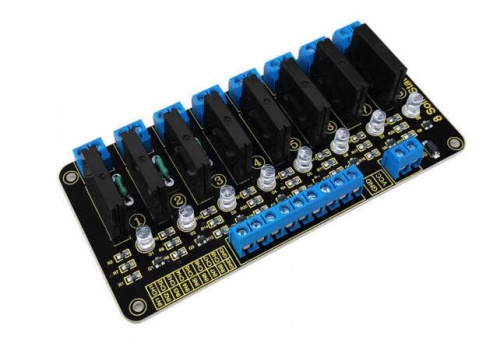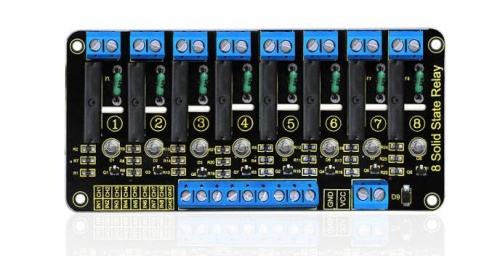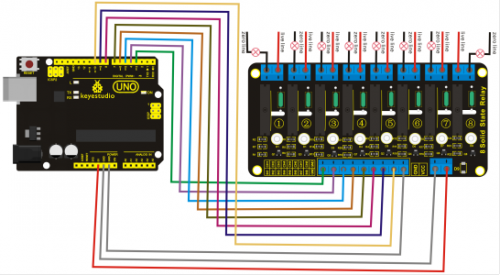Ks0266 keyestudio Eight-channel Solid State Relay Module: Difference between revisions
Keyestudio (talk | contribs) |
Keyestudio (talk | contribs) |
||
| Line 119: | Line 119: | ||
==Buy from == | ==Buy from == | ||
'''Official Website''' | |||
http://www.keyestudio.com/keyestudio-eight-channel-solid-state-relay.html | http://www.keyestudio.com/keyestudio-eight-channel-solid-state-relay.html | ||
[[category:Module]] | [[category:Module]] | ||
Revision as of 13:44, 16 November 2017
Keyestudio Eight-channel Solid State Relay Module
Introduction
Keyestudio eight-channel solid state relay is a high level and effective solid state relay, that is to say, the input control signals is the high level (3.3-5 V), the relay is on; while the input control signal is high level (0-2.5 V), the relay is off. Solid State Relay is a new kind of contactless switching device which is composed of all solid state electronic components. Compared with the electromagnetic relay, its reliability is more higher, with the features of non-contact, long service life, fast and less outside interference. The output control terminal of the keyestudio solid-state relay must be connected to the circuit, and its working current needs to be bigger than 50mA, so that the solid state relay can be disconnected normally.

Performance Parameters
- Electrical parameters:
| Voltage | Static Current | Working Current | Trigger Voltage | Trigger Current | |
|---|---|---|---|---|---|
| Channel 1 | DC 5V | 0mA | 13.8mA | 3.3-5V | 2mA |
| Channel 2 | DC 5V | 0mA | 26.8mA | 3.3-5V | 2mA |
| Channel 3 | DC 5V | 0mA | 37mA | 3.3-5V | 2mA |
| Channel 4 | DC 5V | 0mA | 48mA | 3.3-5V | 2mA |
| Channel 5 | DC 5V | 0mA | 59mA | 3.3-5V | 2mA |
| Channel 6 | DC 5V | 0mA | 70mA | 3.3-5V | 2mA |
| Channel 6 | DC 5V | 0mA | 81mA | 3.3-5V | 2mA |
| Channel 6 | DC 5V | 0mA | 90mA | 3.3-5V | 2mA |
- Output port : AC240V/2A
Connection Diagram
Sample Code
int BASE = 3 ; //The first relay I/O port
int NUM = 8 //Total number of relay
void setup()
{
for (int i = BASE; i < BASE + NUM; i ++)
{
pinMode(i, OUTPUT); //Set the digital I/O port to output
}
}
void loop()
{
for (int i = BASE; i < BASE + NUM; i ++)
{
digitalWrite(i, HIGH); //Set the digital I/O port outputs to "HIGH", that is, gradually open relay
delay(200); //delay
}
for (int i = BASE; i < BASE + NUM; i ++)
{
digitalWrite(i, LOW); //Set the digital I/O port outputs to "LOW", that is, gradually close relay
delay(200); //delay
}
}
Result
Wiring as the above image, after powered-on, eight-channel solid state relays are first connected and then broken successively,repeating alternately.
Resource
PDF:
https://drive.google.com/open?id=1bVGkOans_UoWegSrJs8Ft3D4GEKakp-1
Buy from
Official Website
http://www.keyestudio.com/keyestudio-eight-channel-solid-state-relay.html

